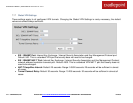
CRADLEPOINT IBR650 | USER MANUAL Firmware ver. 3.3.0
© 2011 CRADLEPOINT, INC. PLEASE VISIT HTTP://KNOWLEDGEBASE.CRADLEPOINT.COM/ FOR MORE HELP AND RESOURCES PAGE 90
7.7.3 Page 3: IKE Phase 1
IKE security has two phases, Phase 1 and Phase 2. You have the ability to distinctly configure each phase, but the default
settings will be sufficient for most users.
To set up a tunnel with a remote site, you need to match your tunnel's IKE negotiation parameters with the remote site. By
selecting several encryption, hash, and DH group options, you
improve your chances for a successful tunnel negotiation. For
greatest compatibility, select all options; for greatest security,
select only the most secure options that your devices support.
Exchange Mode: The IKE protocol has 2 modes of negotiating
phase 1 - Main (also called Identity Protection) and Aggressive.
In Main mode, IKE separates the key information from
the identities, allowing for the identities of peers to be
secure at the expense of extra packet exchanges.
In Aggressive mode, IKE tries to combine as much
information into fewer packets while maintaining security.
Aggressive mode is slightly faster but less secure.
Because it has better security, Main mode is recommended for
most users.
Key Lifetime: The lifetime of the generated keys of Phase 1 of
the IPsec negotiation from IKE. After the time has expired, IKE
will renegotiate a new set of Phase 1 keys.
Encryption, Hash, and DH Groups: Each IKE exchange uses
one encryption algorithm, one hash function, and one DH group
to make a secure exchange.


















